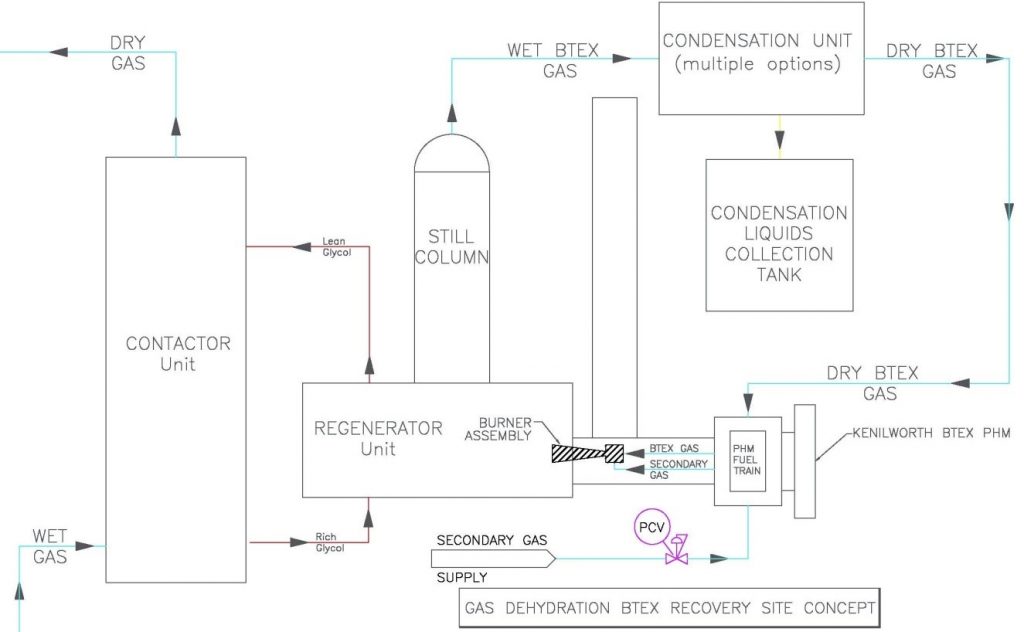The oil and gas industry has been faced with some hard facts as of late. Oil and Gas prices are in a slump while political and environmental pressures are forcing the industry to make serious changes about the way it does business and how its extracts, processes, and distributes end products, both domestically and abroad. History has continued to teach us, however, that in troubled times there are always a few individuals or companies who take on the challenge of changing times and pave the way for others to follow.
One of the challenges at hand is how to effectively capture, utilize, and efficiently destruct the vented BTEX gas from Natural Gas dehydration still columns. The AER states in Directive 39 that producers may emit no more than 1000kg of BTEX into the atmosphere annually and in some cases as little as zero BTEX emissions (see Directive 39 Tables 2 and 3 for details). The AER has set these regulations in place for good reason. BTEX is a carcinogen, and for the health and wellness of everyone, zero emissions of BTEX is ideal. Similarly, throughout Western Canada and the United States, government agencies are increasing limitations on BTEX emissions. Producers that are venting up to their limit or flaring are left wondering how they can continue to operate…but it’s not all dark clouds and bad news. There is a solution for reaching AER emission mandates, and it simpler than you might think! Kenilworth Combustion has solutions to reach emission mandates.
In early 2001, Kenilworth Combustion developed their first Waste Gas Recovery and Utilization system. As opposed to venting or flaring unwanted casing or overhead gas, Kenilworth Combustion devised a method of collecting and utilizing the waste gas as a fuel source. The benefit of this was twofold; 1. No more issues with flaring and 2. A 90% reduction in purchased fuel. This technology was applied to hundreds of single well batteries as well as facilities across Alberta and Saskatchewan with millions of dollars being saved by producers. In 2008, when this proven technology was applied to a Natural Gas Dehydration system, the results were ground breaking. Third party testing later verified that there was a 99.9% BTEX Destruction efficiency (see link to report here). Kenilworth Combustion even received two letters from the Alberta Government commending them on their achievement (see links to letters here and here).
To make things even more exciting, the Kenilworth Combustion system does not require any VRU compressors or auxiliary blowers for combustion, making it low cost and simple to operate and maintain. These systems typically operate from 2-12 ounces of pressure. The system uses the same patented natural draft burner technology that Kenilworth Combustion is known for, and with hundreds of units installed over the last 15 years, they have been proven to work in the field. Below is a simplified schematic of how a typical site works:
Saturated BTEX gas is collected from the still column and enters the condensing unit (there are multiple options for condensing units). The condensation unit provides a critical function in the BTEX gas utilization process, along with drying the BTEX gas to point where it can be combusted for process heating, it also separates out the condensate which is collected and later sold.
Even if there is a small amount of liquid left after the condensation process, the Kenilworth Combustion BTEX Burner can flash off excess liquids. The BTEX Gas now enters the BTEX fueltrain of the Kenilworth Combustion BTEX PHM (Process Heater Module). This is a specially designed fuel train built to handle the specific demands of BTEX gas. In addition to the Low Pressure BTEX fueltrain, there is also a High Pressure Natural Gas fueltrain that provides supplemental fuel in the event that there is not enough BTEX gas to heat the process.
Change in our industry is inevitable. In fact, history shows us it is the only thing we can expect. The changes we are seeing now are the direct result of knowledge we have all gained regarding the impact of our operations on health and wellness in our communities and environment. With this knowledge also comes hope, and beyond that, a real solution to the issues we are facing. Through government regulations and industry support for new technologies, we are all in a position to make this time in history a turning point for a cleaner and brighter future, without sacrificing quality of life.
For more information contact Kenilworth Combustion directly at 780-853-5340 or visit them at www.kenilworth.ca
Share This:





 CDN NEWS |
CDN NEWS |  US NEWS
US NEWS 
































Canada’s Advantage as the World’s Demand for Plastic Continues to Grow